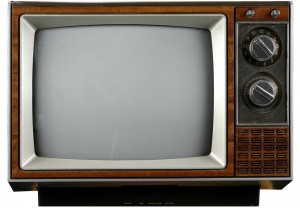Ah, network television.  While network television is ancient history for most of my students’ generation. it remains an important part of American society, and a highly regulated business. Indeed, I suspect the Supreme Court Justices spend more time watching ABC than they do Netflix. (If they watch TV. Don’t you wish you knew what they watched? I do. I bet Scalia watches the Bachelorette, or some other really mindless show. Wouldn’t that give you an entirely different perspective on Justice Scalia? I need to find out from one of my friends who clerked.) Today’s opinion by Justice Breyer in American Broadcasting Companies v. Aereo ruled that the new television technology created and sold by Aereo violates copyright law. Although it is a win for the broadcasters, the opinion focused very little on the broadcasters’ arguments and much more on statutory interpretation through legislative history.
While network television is ancient history for most of my students’ generation. it remains an important part of American society, and a highly regulated business. Indeed, I suspect the Supreme Court Justices spend more time watching ABC than they do Netflix. (If they watch TV. Don’t you wish you knew what they watched? I do. I bet Scalia watches the Bachelorette, or some other really mindless show. Wouldn’t that give you an entirely different perspective on Justice Scalia? I need to find out from one of my friends who clerked.) Today’s opinion by Justice Breyer in American Broadcasting Companies v. Aereo ruled that the new television technology created and sold by Aereo violates copyright law. Although it is a win for the broadcasters, the opinion focused very little on the broadcasters’ arguments and much more on statutory interpretation through legislative history.
Aereo sold thousands of little antennas, through which it would deliver to each customer their own personal copy of a particular television programs via the internet.  Network television shows are broadcast for free, and if you have your own antenna you can watch without cable, internet, or any other paid service. But the actual performance of the shows is protected by copyright laws Aereo argued that its antennas were like DVR recorders — simply hardware to allow customers to get access to TV programs.
Network television shows are broadcast for free, and if you have your own antenna you can watch without cable, internet, or any other paid service. But the actual performance of the shows is protected by copyright laws Aereo argued that its antennas were like DVR recorders — simply hardware to allow customers to get access to TV programs.
Believe it or not, the law that applies here is from 1976. As the Supreme Court opens its opinion, “The Copyright Act of 1976 gives a copyright owner the “exclusive righ[t]” to “perform the copyrighted work publicly.” 17 U. S. C. §106(4).” Thus the Court, in ruling against Aereo, decided that Aereo “performs” the television shows to the “public,” which is in violation of the law unless the copyright holder has consented.
First, the Court decided that Aereo is “performing” the television shows based on the Court’s interpretation of the legislative history of the amendments to the Copyright Act. Aereo argued that only the subscriber performs, because all Aereo does is provide the hardware to allow the subscriber to download the show. In two earlier cases involving the precursor to today’s cable television, the Court ruled that the cable companies were not performing, but merely enhancing the viewer’s capability to watch the shows by broadcasting network television on the cable networks. In response to these decisions, Congress amended the Copyright Act to essentially reverse the decisions. The amended statute defines “perform” an audiovisual work as “show[ing] its images in any sequence or to make the sounds accompanying it audible.” §101 The amended law does not distinguish between viewer and broadcaster in terms of a performance.
Congress also added the Transmit Clause, which defines a performance as public if it communicates to any device whereby images or sounds are received somewhere else.
The Court found that Aereo’s activities are substantially similar to those of the cable companies that Congress was trying to reach with its amendments to the Copyright Act. Thus, Aereo is publicly performing the shows when it provides its service.
Justice Scalia, in his dissent, distinguished Aereo from cable companies in one key way: cable companies covered in the old cases (and targeted by the amendments) constantly broadcast network television. In Aereo’s service, the subscriber chooses a show, and only then does the show get broadcast via the internet to that one viewer. Thus Scalia found Aereo instead to be more like a “copy shop providing its subscribers with a library card.”
The majority remains unconvinced, reasoning that in the cable television cases the Court noted that the viewer could change the channel and watch a different show (“turn the knob” is the old-fashioned language that was used), so cable isn’t that different.
Regardless, the majority was careful to limit its ruling to Aereo, which protects cloud computing technology for now. There was significant concern in the technology sector about the impact of the ruling in Aereo, because Aereo relies on the cloud just as so many other technologies do today. But the Court was careful to state that it would deal with the cloud technology when it was before the Court, and for now focused narrowly on the technology that allows viewers to watch shows nearly live (as opposed to downloaded for later viewing).
This case has huge implications for the television industry, and despite the Court’s careful wording, probably will have some impact on future digital innovation. What do you think?
